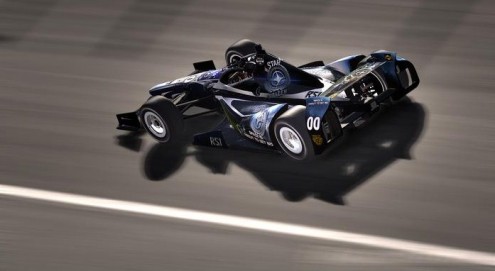
The Kitchen Sink: Preparing the DW12 for Race Day
July 11th, 2014 by Jaime Baker

Previous: DW12 Technical Introduction
Earlier this season I wrote an article (with more than a little help from Eric Hudec) discussing the new Dallara DW12 IndyCar. However, what I didn’t talk about was how hard this car was to drive in traffic. The “aero-push” as some have called it is drawing a lot of attention from the IndyCar faithful and combating it is a whole new beast.
So far we have seen two big races in the DW12. One being the “unofficial” Top-Split Indy 500, the other being the ISOWC Pocono 500. I participated in both races. In the Indy 500 I was an early exit, but ran enough laps to get an idea of how the aero-push impacted the car – it was significant. At Pocono I knew it was going to be an issue, but never really had a chance to see how my car handled as I put myself out of the race after completing just one lap when I hit a bump in Turn One and bobbled into the wall. So, I have a few ideas of what I’m going to do to make sure I actually finish this upcoming Indy 500.
The first thing I’m going to do is try to make my car drive well in traffic. Even if your car is the fastest up front, that is not going to be matter because of how far back the slip stream works. One way you can make your car drive well in traffic is by adjusting your setup. Another way is by working with the tools in the car (weight jacker, anti-roll bar blades, and fuel mapping). The last way I’m going to make my car drive well in traffic is by “uninstalling” my lead foot and coming off the throttle before corner entry (this is generally a good idea). Let us take a look at what each in car adjustment can help us achieve as well as setup parameters before we go around throwing The Kitchen Sink at it.
IN-CAR ADJUSTMENTS
So, in-car adjustments is probably where I would start. If you are suffering terrible aero push, it might be a good idea to bring the front anti-roll bar blade to setting 1. If this is enough to make you comfortable in the draft, then good for you, you have a good car. If it isn’t enough you can try raising the rear anti-roll bar blade up as high as 6 to loosen up. Other options in the in-car adjustment involve changing the weight-jacker. This is the most common change. Doing this will completely change the balance of your car. In the draft you are going to want to raise your weight-jacker, but don’t forget to lower it when you make your pass or you may very well find yourself on a knife edge and gliding right into the wall.
If you are going to rely on in-car adjustments, just remember that practice makes perfect and don’t go in there unprepared. Fuel mapping is probably going to help you the least. However, using it strategically is a good advantage. You are going to get a huge run in the draft, experiment with lower fuel maps and try to give yourself a bit more time to hit top speed. You don’t need to be on the guy’s gear box if you aren’t making a pass. If you can get close then that should be enough, plus you will save time in the pits when he has to add more fuel. Most importantly: KNOW WHAT YOUR CAR CAN AND CAN’T DO BEFORE REMAKING YOUR ENTIRE SETUP.

In-car and behind the wall adjustments only go so far without complimentary adjustments in driving style. (Image Miitro Kemppainen)
BEHIND THE WALL ADJUSTMENTS
In the garage you can also change a few things. An easy change is to throw on a ton of downforce and make the thing handle like a go kart in the draft. However, odds are that if you do this you will not be able to make any passes as your car will have so much drag that the moment you pull out of the slip stream you will parachute back a few car lengths. So, a good idea would be to add a moderate amount of wing angle or increase aerodynamic pieces just a little bit in surface area. Besides this, I would argue mechanical adjustments would be a good idea. Probably the best idea would be too soften the front anti roll bar or remove it all together. This can help you in the draft and also when riding around with a heavy fuel load.
Other changes you can make are lowering the front ride height a bit to help the car turn. In order to compensate for the lack of downforce, you could also lower the right front spring rate a bit to give the car more mechanical grip rather than more aerodynamic control (you don’t need aerodynamic control because the car in front is taking a lot of downforce off of you). To the contrary you could also stiffen up the right rear spring rate, this will help rotate the car through the corner.
DRIVING STYLE
This is the area where you can gain the most out of any competitor in the field. If you are too aggressive you can end your own race early, but if you are conservative you can let positions fall into your lap. I recall in the 16th Street Indy 400 that I started 42nd or close to it, yet managed to sneak out with an 11th place finish (was P8 before crashing). The reason for this was I avoided all the wrecks and didn’t put myself in senseless situations. That was with the old car. With the new car, the attrition rate is even higher. At the Indy 500 and Pocono 500 races I’ve done so far, we saw only 10 cars finish at Pocono and less than that at Indy, even with large grids.There’s not a whole lot to gain driving like a kamikaze.
You can also create downforce for yourself by driving intelligently in the draft. Obviously the driver ahead is going to take the optimal line on turn in and exit. Try driving slightly to the left of his line on entry and exit, putting a little bit of downforce on your wing and getting you through the corner with a margin for error. All you need to do is put your wing endplate under the other driver; you don’t need to overdo it.















































